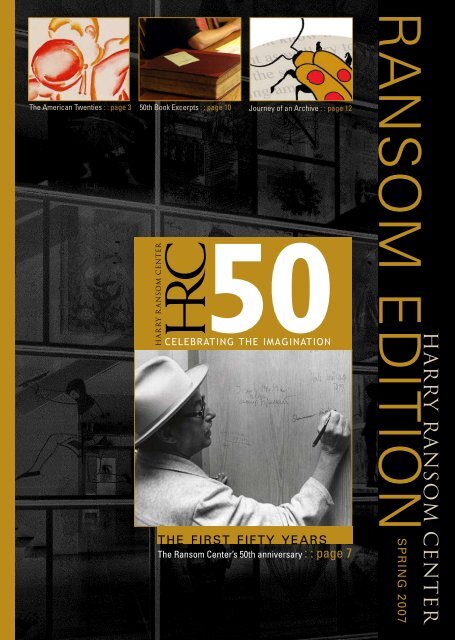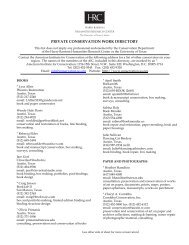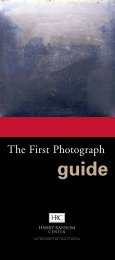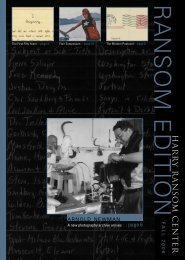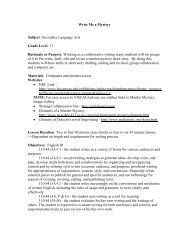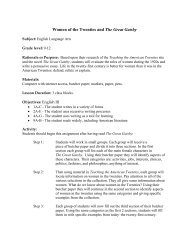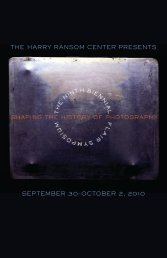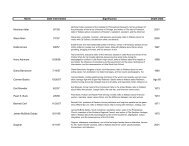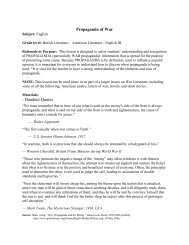Download PDF Version - Harry Ransom Center - The University of ...
Download PDF Version - Harry Ransom Center - The University of ...
Download PDF Version - Harry Ransom Center - The University of ...
Create successful ePaper yourself
Turn your PDF publications into a flip-book with our unique Google optimized e-Paper software.
Recent Acquisitionsrichard oram“<strong>The</strong>re is no secret about my place <strong>of</strong> birth,”blustered Evelyn Waugh in a 1948 memorandumto Time magazine, “but I refuse to answerimpertinent questions on the telephone from unknownyoung women on Sunday evenings.”<strong>The</strong> corrected typescript <strong>of</strong> this characteristiceffusion is one <strong>of</strong> the items recently acquired fromthe extensive Waugh collection <strong>of</strong> <strong>Ransom</strong> <strong>Center</strong>Advisory Council member Sam Radin.<strong>The</strong> most significant item in the collection, a giftfrom Mr. Radin, is the suppressed pamphlet An OpenLetter to His Eminence the Cardinal Archbishop <strong>of</strong>Westminster (1933). Waugh wrote the booklet asa reply to Catholic critics <strong>of</strong> his controversial novelBlack Mischief. At the time the novelist was pursuingan ecclesiastical annulment <strong>of</strong> his first marriage,and he was convinced to withdraw the Open Letterfrom circulation. Perhaps six copies survived; thepamphlet, however, became so scarce that Waughhad to purchase one for his own library in the 1950s.Today, this very copy is the only one known to exist.It now joins the original manuscript <strong>of</strong> the pamphletalready at the <strong>Ransom</strong> <strong>Center</strong>. <strong>The</strong> new arrival alsocompletes the collection <strong>of</strong> Waugh’s separatelypublished works at the <strong>Center</strong>.Other items acquired from Radin’s library includeseveral letters by Waugh and pro<strong>of</strong> copies <strong>of</strong>Waugh novels, including a bound, corrected pro<strong>of</strong> <strong>of</strong>A Handful <strong>of</strong> Dust and galleys <strong>of</strong> the Americanedition <strong>of</strong> his masterpiece, Brideshead Revisited.Other recent acquisitions include::: A large collection <strong>of</strong> manuscript materials and photographs relatedto Henry Miller, including his earliest letters known to survive,which were written to his first wife, Beatrice Wickens, between1915 and 1925. <strong>The</strong> collection also includes, among other items,Henry Miller’s “Dream Book,” the last unpublished book-lengthmanuscript he wrote during his Paris years.:: A substantial addition to the archive <strong>of</strong> James Salter, includingextensive correspondence with two <strong>of</strong> Salter’s closest friends andmaterials for the books Last Night, <strong>The</strong>re and <strong>The</strong>n, and Life Is Meals.2007 promotional sponsors.<strong>The</strong> <strong>Ransom</strong> <strong>Center</strong> would like to give special thanks to our 2007 promotional sponsors:Memo from Evelyn Waugh to Time magazine, dated December 16, 1948, correctingthe reporter’s inaccuracies in a story about Waugh in the July 12, 1948 issue.:: A unique print from a snapshot Richard Avedon took <strong>of</strong> TrumanCapote in 1967, when Capote returned to Holcomb, Kansas,for the shooting <strong>of</strong> the film In Cold Blood. <strong>The</strong> image depicts Capotein a dimestore, holding a devil mask to his face. Capote gave the printto Alvin Dewey, the Kansas Bureau <strong>of</strong> Investigation agent wholed the investigation <strong>of</strong> the Clutter murders, in gratitude for hisassistance with research for Capote’s book.Learn more about the Evelyn Waugh and James Salter archives at8http://www.hrc.utexas.edu/ransomedition.January 30–July 29, 2007<strong>The</strong> American Twenties<strong>The</strong> United States emerged from World War Iwith wealth and power and an urge to remakeitself. Pr<strong>of</strong>ound cultural and social changeoccurred during the 1920s, a decade <strong>of</strong>ambiguities, contradictions, contrasts, andconflicts. In the decade’s struggle to define thefuture <strong>of</strong> America, a plethora <strong>of</strong> issues wereargued and fought out in poetry, novels, politicaltracts, music, and the movies. Issues <strong>of</strong> race,religion, and revolution were paramountfollowed by those <strong>of</strong> love, sex, and gender.Questions <strong>of</strong> the primacy <strong>of</strong> labor and capitalwere particularly fraught, and the benefits <strong>of</strong>socialism, communism, anarchism, andcapitalism were openly debated.Fundamentalists and experimentalists clashed inmany areas <strong>of</strong> human endeavor. Through these,the idea <strong>of</strong> the “modern” was crystallized andthe “American” century born. Thisexhibition is an exploration <strong>of</strong> that decadethrough the literature and art that was to becomequintessentially American andquintessentially modern.<strong>The</strong>mes explored in this all-gallery exhibition <strong>of</strong>materials drawn primarily from the <strong>Ransom</strong> <strong>Center</strong>’s collections include “Remembering the War,” “Babbittsand Bohemians,” “Modernist Monuments,” “Labor and Capital,” “<strong>The</strong> Rise <strong>of</strong> Women,” “Hollywood’s DreamFactory,” “House and Home,” “Cops and Robbers,” “Cowboys and Indians,” “<strong>The</strong> New Negro,” “In the AmericanGrain,” and “<strong>The</strong> Voice <strong>of</strong> the People.”<strong>The</strong> exhibition is guest-curated by Rodney Phillips, a Librarian at the <strong>University</strong> <strong>of</strong> Arizona Poetry <strong>Center</strong>, Tucson,and former administrator and curator at the New York Public Library.FROM the american twentiesTop: Journal American pressphoto <strong>of</strong> “<strong>The</strong> Charleston.”Right: Presentation drawingin the “Jazz Lint” seriesby Gordon Conway.ca. 1924–1928.Far right: Harlem Dandy, UndatedMiguel CovarrubiasLitho crayon drawing27.7 x 21.3 cm (10.9 x 8.4 in)Courtesy <strong>of</strong> theMiguel Covarrubias Estate.All Rights Reserved.IN THE GALLERIESTOURS EVERY SATURDAY at 2 P.M.Take a free guided tour <strong>of</strong> the exhibition<strong>The</strong> American Twenties through Saturday, July 28.<strong>Ransom</strong> Edition : : <strong>Ransom</strong> Edition : :
Fifty Years <strong>of</strong> Major Acquisitions and EventsFounded in 1957, the <strong>Harry</strong> <strong>Ransom</strong> <strong>Center</strong> at <strong>The</strong> <strong>University</strong> <strong>of</strong> Texas at Austin hasevolved into a world-renowned cultural institution. Throughout 2007, the <strong>Ransom</strong><strong>Center</strong> commemorates its 50th anniversary with programs and exhibitionsdedicated to “Celebrating the Imagination.”Captions can be found at8 http://www.hrc.utexas.edu/ransomedition.1957 1958 1959 1962 1963 1964 1965 1968 1969 1971 1973 1975 1978 1980 1981 1982 1984 1986 1988 1992 1994 1996 1997 2000 2002 2003 2005 2006<strong>Harry</strong> <strong>Ransom</strong> named directorArchive <strong>of</strong> theater and industrial designer Norman Bel GeddesArchive <strong>of</strong> playwright Oscar Wilde, including major works andcorrespondenceArchive <strong>of</strong> Tennessee Williams, including manuscripts for 1,000plays, screenplays, stories, essays, and poemsHelmut Gernsheim collection, a photohistorical archive thatincludes the First Photograph (ca. 1826)William Blake art collection, containing the author-artist’sengravings, watercolors, and drawingsNickolas Muray collection <strong>of</strong> Mexican art, including works byFrida Kahlo, Miguel Covarrubias, Rufino Tamayo, and Diego RiveraRanuzzi family archive <strong>of</strong> Italian manuscripts from the15th to 18th centuriesCarlton Lake collection <strong>of</strong> modern French literature, art, and musicOpening <strong>of</strong> <strong>Harry</strong> <strong>Ransom</strong> <strong>Center</strong> buildingCorrespondence between Maximilian, Emperor <strong>of</strong> Mexico, and hiswife CarlotaArchive <strong>of</strong> George and Ira Gershwin, including works, a scrapbook,and correspondenceGutenberg Bible (ca. 1455), one <strong>of</strong> five complete copies in theUnited StatesCreation <strong>of</strong> the Conservation Program, responsible for the care <strong>of</strong>the <strong>Center</strong>’s holdingsArchive <strong>of</strong> Hollywood producer David O. Selznick, includingmaterials related to Gone With the WindGloria Swanson archive containing correspondence, productionpapers, her autobiography, more than 500 books and film scripts, and20,000 photographsArchive <strong>of</strong> playwright Arthur MillerPforzheimer library <strong>of</strong> early English literatureThomas F. Staley named directorArchive <strong>of</strong> photographer Eliot Elis<strong>of</strong>onInitiation <strong>of</strong> the Fleur Cowles Flair SymposiumDavid Douglas Duncan’s photography archive, spanning over sixtyyears <strong>of</strong> award-winning photojournalismLiterary papers <strong>of</strong> writer Leon UrisArchive <strong>of</strong> writer and amateur photographer Sanora Babb, includingher WPA work among the displaced in Depression-era CaliforniaPapers <strong>of</strong> British novelist Julian BarnesRenovation <strong>of</strong> <strong>Ransom</strong> <strong>Center</strong>, with the addition <strong>of</strong> publicgalleries, a theater, and new research facilitiesNorman Mailer archive, containing materials associated with everyone <strong>of</strong> Mailer’s literary projectsFilm archive and costume collection <strong>of</strong> actor, director, producerRobert De Niro
Collecting the Imagination:<strong>The</strong> First Fifty Years <strong>of</strong> the<strong>Ransom</strong> <strong>Center</strong>In celebration <strong>of</strong> its 50th anniversary, the <strong>Ransom</strong> <strong>Center</strong> ispublishing a richly illustrated chronicle <strong>of</strong> its history. This work tracesthe <strong>Center</strong>’s growth from the founding <strong>of</strong> the <strong>University</strong>, when theadministration began to collect library materials to support theresearch <strong>of</strong> its students and faculty, to the birth <strong>of</strong> <strong>Harry</strong> <strong>Ransom</strong>’sidea to establish a research center in the humanities that wouldbe for the state <strong>of</strong> Texas what the Bibliothéque Nationale is forFrance. This history follows the execution <strong>of</strong> <strong>Ransom</strong>’s idea and theexplosive growth <strong>of</strong> the collections under his leadership. It describesthe evolution <strong>of</strong> the <strong>Center</strong> under a succession <strong>of</strong> directors, librarians,and curators over the past fifty years, and the rise <strong>of</strong> its reputation.Perhaps most important, this work tells the story <strong>of</strong> the <strong>Center</strong>’scollections, not only how they came from disparate corners <strong>of</strong> theworld to reside in the heart <strong>of</strong> Texas, but also the philosophy behindtheir acquisition and the <strong>Center</strong>’s commitment to share its holdings—from the Gutenberg Bible and the First Photograph to the manuscripts<strong>of</strong> James Joyce, D. H. Lawrence, Tennessee Williams, and NormanMailer—with the public.A collaboration <strong>of</strong> several staff members, Collecting theImagination: <strong>The</strong> First Fifty Years <strong>of</strong> the <strong>Ransom</strong> <strong>Center</strong> will beavailable in April 2007 as the newest book in the <strong>Ransom</strong> <strong>Center</strong>’sImprint Series, published by the <strong>University</strong> <strong>of</strong> Texas Press.Excerpt from Collecting the Imagination: <strong>The</strong> First Fifty Years <strong>of</strong> the <strong>Ransom</strong> <strong>Center</strong>Why Texas?Why did Alfred and Blanche Knopf donate their personal library andtheir publishing firm’s archive to <strong>The</strong> <strong>University</strong> <strong>of</strong> Texas at Austin?<strong>The</strong>ir business was based in New York City. Alfred was a graduate <strong>of</strong>Columbia <strong>University</strong>, and some <strong>of</strong> the firm’s records had already beengiven to the New York Public Library when Knopf was first approachedby <strong>Ransom</strong>. Why did they choose Texas?While the immediate answer does not emerge until the late 1950s,one can trace the Knopfs’ association with Texas back to 1941 when,on a trip through Dallas, Austin, San Antonio, and El Paso, they metthe Stanley Marcuses, J. Frank Dobie, John Henry Faulk, WalterPrescott Webb, Maury Maverick, and other prominent Texans withwhom they maintained personal friendships and business contacts.<strong>Ransom</strong> and Alfred Knopf were introduced to one another over lunchat the St. Regis Hotel in New York City on June 22, 1959. <strong>Ransom</strong>described the program he was building at the <strong>University</strong> andexpressed interest in making Knopf’s personal library a part <strong>of</strong> thisenterprise. Knopf was so impressed by <strong>Ransom</strong>’s activities that hecommitted both his library and the firm’s papers to <strong>The</strong> <strong>University</strong><strong>of</strong> Texas. Contemporaneous with the Knopf gift was the 1960 donation byErle Stanley Gardner <strong>of</strong> his papers and library, one <strong>of</strong> the mostcomplete records <strong>of</strong> a writing career ever made. When asked abouthis choice <strong>of</strong> repository, Gardner, the author <strong>of</strong> the Perry Masonseries, acknowledged that he had been approached by several otheruniversities but “had selected <strong>The</strong> <strong>University</strong> <strong>of</strong> Texas because <strong>of</strong>his friendship with Dr. [Merton] Minter [then chairman <strong>of</strong> the Board<strong>of</strong> Regents] and Park Street, a San Antonio lawyer with whom he[had] been intimately associated in the Court <strong>of</strong> Last Resort fornearly 12 years.”“My friendship with these men, plus the fact that I am an honorarycaptain in the Texas Rangers is an association with Texas thatmakes me feel I am virtually a citizen <strong>of</strong> the state.”Perhaps it helped that in consideration <strong>of</strong> the gift, <strong>Ransom</strong> agreedto recreate and maintain on permanent exhibition Gardner’s study,which was moved from his Rancho del Paisano near Temecula,California, and now resides on the fourth floor <strong>of</strong> the FlawnAcademic <strong>Center</strong> on the <strong>University</strong>’s campus.Scholars at WorkExcerpt from Collecting the Imagination: <strong>The</strong> First Fifty Years <strong>of</strong> the <strong>Ransom</strong> <strong>Center</strong>Beginning with Reginald Griffith’s Alexander Pope: A Bibliography,published in 1922 by <strong>The</strong> <strong>University</strong> <strong>of</strong> Texas, there is a long history <strong>of</strong>celebrated works that resulted from research conducted in the <strong>Ransom</strong><strong>Center</strong>’s collections. Among the most notable are:Collected Letters <strong>of</strong> George Bernard Shaw, editedby Dan H. Laurence (London: Max Reinhardt, 1965–1988;New York: Dodd, Mead, 1965–1988)Internationally recognized Shavian scholar Dan H. Laurence consultedthe 4,000 letters in the <strong>Ransom</strong> <strong>Center</strong>’s George Bernard Shawcollection for this four-volume work.<strong>The</strong> Cambridge Edition <strong>of</strong> the Letters and Works <strong>of</strong>D. H. Lawrence (Cambridge, 1979– )This massive series—including eight volumes <strong>of</strong> letters and morethan 30 volumes <strong>of</strong> novels, essays, and other works—providesauthoritative texts <strong>of</strong> the writings <strong>of</strong> this important British writer.<strong>The</strong> <strong>Ransom</strong> <strong>Center</strong>’s extensive collection <strong>of</strong> Lawrence’s manuscriptsand letters was consulted for many <strong>of</strong> the books in this series.Bernard Shaw by Michael Holroyd (London: Chatto & Windus,1988–1992; (New York: Random House, 1988–1992)Also drawing heavily on the <strong>Ransom</strong> <strong>Center</strong>’s collection <strong>of</strong> Shawmaterials—which includes manuscripts <strong>of</strong> 419 works, books fromShaw’s personal library, sketches, photographs, financial records,and other items—is Holroyd’s monumental six-volume biography.Anne Sexton: A Biography by Diane Wood Middlebrook(Boston: Houghton Mifflin, 1991)Middlebrook’s controversial and revealing biography, which tooka decade to complete and was nominated for the National Book Award,drew extensively on the complete archive <strong>of</strong> Anne Sexton—comprisinghundreds <strong>of</strong> pages <strong>of</strong> unpublished poems, as well as manuscripts <strong>of</strong> herpublished works, travel notebooks and journals, letters, photographs,and other items—housed at the <strong>Ransom</strong> <strong>Center</strong>.<strong>The</strong> reading room at the <strong>Ransom</strong> <strong>Center</strong>.Tom: <strong>The</strong> Unknown Tennessee Williams by Lyle Leverich(New York: Crown, 1995)Leverich’s biography provides the authoritative account <strong>of</strong> theearly life <strong>of</strong> Tennessee Williams. Leverich consulted the <strong>Ransom</strong><strong>Center</strong>’s voluminous Tennessee Williams archive, which housesmanuscripts <strong>of</strong> more than 1,000 works, including his early plays,essays, screenplays, stories, and poems, as well as hiscorrespondence and photos <strong>of</strong> his apprentice years.<strong>The</strong> Selected Letters <strong>of</strong> Tennessee Williams,edited by Albert J. Devlin and Nancy M. Tischler(New York: New Directions, 2000–)This multi-volume edition <strong>of</strong> the correspondence <strong>of</strong> one <strong>of</strong> America’sfinest playwrights was based, in part, on the sizable collection <strong>of</strong>letters in the <strong>Ransom</strong> <strong>Center</strong>’s Tennessee Williams archive.<strong>The</strong>y reveal Williams to be one <strong>of</strong> the best and most entertainingAmerican letter writers <strong>of</strong> the century.Accomplished biographer and literary historian StanleyWeintraub, one <strong>of</strong> the most prolific scholars to use the collections,has published more than 15 books that were based on researchhe conducted at the <strong>Ransom</strong> <strong>Center</strong>. He wrote about the <strong>Center</strong>in an article for <strong>The</strong> Texas Humanist:To work at the HRC as a scholar is (to put the experience in foodterms) like going to a luxury-class restaurant. <strong>The</strong> service ispersonal and superior, the menu enormous and sumptuous. <strong>The</strong>problem can be a severe case <strong>of</strong> writer’s indigestion if not enoughtime is allowed to consume the full plate. After all, the HRC hasthousands <strong>of</strong> letters by Dante Gabriel Rossetti, D. H. Lawrence,Lytton Strachey, Evelyn Waugh, and Bernard Shaw; the manuscriptsor corrected typescripts <strong>of</strong> William Faulkner’s Absalom! Absalom!,E. M. Forster’s A Passage to India, Arthur Miller’s Death <strong>of</strong> aSalesman, Oscar Wilde’s Lady Windermere’s Fan, T. H. White’s <strong>The</strong>Once and Future King,… Dylan Thomas’s Under Milkwood, GrahamGreene’s <strong>The</strong> Power and the Glory, Aldous Huxley’s Brave NewWorld, Somerset Maugham’s <strong>The</strong> Moon and Sixpence. It is hardlypossible to write a book on a modern master, English or American(or even French) without touching down at the HRC.<strong>Ransom</strong> Edition : : 10 <strong>Ransom</strong> Edition : : 11
Journey <strong>of</strong> an Archive::Bugs, Mold, and Conservation<strong>The</strong> path materials take from the <strong>Harry</strong> <strong>Ransom</strong> <strong>Center</strong> loading dock intoan exhibition in the <strong>Ransom</strong> <strong>Center</strong> Galleries is lengthy and complex.This article is the first in a series that details this journey.suzy banks : : Illustrations by marybeth daigleMary Baughman, a <strong>Harry</strong> <strong>Ransom</strong> <strong>Center</strong> book conservator, huntsbugs. When she discovers them in materials at the <strong>Center</strong>, shedestroys them, typically with a 72-hour stint in a freezer at 20degrees centigrade or below. But don’t ask Baughman which <strong>of</strong>the cellulose-munching bugs she wishes didn’t exist at all. “That’sjust silly,” she says. “<strong>The</strong>re’s a place on this earth for all <strong>of</strong> them.”As long as that place isn’t the <strong>Ransom</strong> <strong>Center</strong>’s collection.When boxes <strong>of</strong> materials first arrive at the <strong>Center</strong>, teams <strong>of</strong>conservators and archivists gather at tables in the quarantine roomin the basement to inspect each folder, envelope, book, and slip<strong>of</strong> paper, looking for telltale signs <strong>of</strong> bugs—as well as for mold,another great enemy <strong>of</strong> archives. Finding and identifying the bugsin the works takes the thoroughness <strong>of</strong> a forensic pathologist anda familiarity with frass (insect excrement). Beetles leave behinda fine granular powder, while silverfish leave tiny black flecks. Bigragged bites from the paper, brown splatters <strong>of</strong> vomit, and shinybrown egg sacks are evidence <strong>of</strong> past or present roaches.Despite possible encounters with wood-boring beetles and fungusand such, opening the boxes, even for longtime inspectors, is stillas exciting as Christmas. Sure, considering the sheer volume<strong>of</strong> material inspected, some boxes yield the giftequivalent <strong>of</strong> socks or steak knives, but othersbear unexpected treasures such asphotographic negatives <strong>of</strong> Frida Kahloor handwritten pages <strong>of</strong> notes by alittle-known writer on her lengthyconversations with Diego Rivera.Many materials arrive carefullypacked and preserved, while othersappear to have been swept pell-mell<strong>of</strong>f a cluttered table directly into thebox—chips <strong>of</strong> ceiling plaster, used tissues,and all.Still, Baughman says very fewmaterials arrive with full-blowninfestations, recalling only two in the past ten years—a box fromPuerto Rico that brought its entourage <strong>of</strong> termites with it and a collection<strong>of</strong> photographs from San Antonio that Baughman remembers as“pretty gnarly.”Although the <strong>Ransom</strong> <strong>Center</strong> turns 50 this year, the conservationdepartment’s program to intercept insects before theyenter the building has been around a little more than halfas long, growing in part out <strong>of</strong> the discovery in the 1980s<strong>of</strong> drugstore beetles dining on several volumes <strong>of</strong> <strong>The</strong>Works <strong>of</strong> St. Augustine, printed in Venice in 1729.<strong>The</strong> initial treatment with moth balls—a standard <strong>of</strong>the times, but now obsolete—simply stunned the larvae,who recovered to eat again until finally meeting a chillydemise in a freezer.<strong>The</strong> treatment <strong>of</strong> mold, a specialty <strong>of</strong> Olivia Primanis, the chiefbook conservator with the <strong>Center</strong>, has likewise changedtack over the years. “Previously, everyone tried to killmold,” she says. But its ubiquity and tenacity proved that an impossibletask. Now, mold is instead removed and contained—mainly by changingits environment by eliminating heat and, especially, humidity. Buteven when mold is removed—even if it could be killed—its properties,such as allergens and toxins, still remain. So moldy items are marked assuch, to serve as a sort <strong>of</strong> disclaimer to patrons, who may then choose towear a mask or even review moldy materials under a fume hood.“Mold is harder to get rid <strong>of</strong>, but bugs are sneakier,” Baughman says.Case in point <strong>of</strong> this sly cunning: A Japanese book <strong>of</strong> law dating from thelate nineteenth century with a tiny hole no bigger than a freckle in thespine. Open the book and the handiwork <strong>of</strong> a beetle larva is revealed,an inch-long tunnel snaking through the pages. But there willbe no light at the end <strong>of</strong> this tunnel; the bug wasstopped in its tracks via deep freeze.Eliminating bugs in paper products may be a snap—especiallyin the <strong>Center</strong>’s walk-in freezer—but some materials, such as leather,ivory, and painted canvas or wood, can be damaged by freezing. Sprayingwith pesticides is not anoption, as this can harm both collection materials and the scholarswho stick their noses in them. Besides, treating with pesticides is seldomeffective because bugs usually live within the materials, not on thesurfaces.Instead, materials that show signs <strong>of</strong> previous insect encampments maybe placed under observation, like the painting on a wooden panel thatBaughman has sealed in a double-sided Plexiglas frame so she can spotthe possible emergence <strong>of</strong> adult beetles. And if the beetles do surface?<strong>The</strong>n what? <strong>The</strong> object might earn a four-month stretch in an oxygen-freeenvironment.And afterwards, you can trust that Baughman and the other conservatorswill still be keeping an eye on it.Office supplies thatbug archivistsMary Baughman may be loatheto wish extinction on thenatural pests <strong>of</strong> archive materials,but she’s not so generous when itcomes to man-made banes—rubberbands, staples, paper clips, and,perhaps most despised, packingpeanuts. Rubber bands crush fragileedges and, with aging, stick to anddiscolor paper. Staples and paperclips rust, shedding black flakes thatstain pages and mimic bugdroppings. A packing peanut cancause damage as it works its waybetween papers and pages. Andthose environmental darlings, thedissolving peanuts, are even morenefarious; made <strong>of</strong> cellulose, theseserve as tantalizing bug food.Her best advice for homepreservationists? Keep it clean,keep it <strong>of</strong>f the floor, and, above all,keep it dry. “Once things get wet,”she says, “I think they give <strong>of</strong>fan aroma to bugs that says,‘Dinner’s ready.’”— Suzy Banks<strong>Ransom</strong> Edition : : 12 <strong>Ransom</strong> Edition : : 13
CALENDAR<strong>Harry</strong> <strong>Ransom</strong> <strong>Center</strong>SPRING/SUMMER 2007THURSDAY, JANUARY 18, 3:30 P.M.JESSEN AUDITORIUMPANEL Journalists Bob Woodward and CarlBernstein participate in panels on presidentialaccountability and the impact <strong>of</strong> the press in theWatergate scandal. Additional panelists includePulitzer Prize–winner David Oshinsky, Pr<strong>of</strong>essor<strong>of</strong> Government Bruce Buchanan, and AustinAmerican-Statesman Editor Rich Oppel. Eventbrought to you by the Austin American-Statesmanand statesman.com.Details at www.hrc.utexas.edu/watergate.THURSDAY, FEBRUARY 1, 7 P.MTOUR Curator Rodney Phillips leads a gallerytour <strong>of</strong> the exhibition <strong>The</strong> American Twenties.FRIDAY, FEBRUARY 2, 7 P.M.JanuaryfebruaryPERFORMANCE <strong>The</strong> Violet Crown RadioPlayers produce a live radio broadcast <strong>of</strong> JamesJoyce’s “<strong>The</strong> Dead,” in celebration <strong>of</strong> the writer’s125th birthday.WEDNESDAY, FEBRUARY 7, NOONREADING Poetry on the Plaza: Jazz PoetryTHURSDAY, FEBRUARY 8, 7 P.MLECTURE Kate Holliday, Assistant Pr<strong>of</strong>essor <strong>of</strong>Art History at Southwestern <strong>University</strong>, presents“Humanism and Modernism: <strong>The</strong> Idea <strong>of</strong>American Art Deco.”THURSDAY, FEBRUARY 15, 7 P.M.PERFORMANCE Department <strong>of</strong> <strong>The</strong>atre andDance graduate students premiere a set <strong>of</strong> originalperformance pieces in the Voices <strong>of</strong> the AmericanTwenties museum theater series, which bringscharacters from the 1920s to life.TUESDAY, FEBRUARY 20, 7 P.M.ROBERT DE NIRO FILM SERIES Brian DePalma’s Greetings (1968), starring Robert De Niro,Gerrit Graham, and Jonathan Warden. AssociateCurator <strong>of</strong> Film Steve Wilson introduces the film anddiscusses selected items from the De Niro collection.TUESDAY, JANUARY 30, noon–7 P.M.BIRTHDAY PARTY <strong>University</strong> students,faculty, and staff are invited to a party celebratingthe <strong>Ransom</strong> <strong>Center</strong>’s 50th anniversary withactivities scheduled throughout the day.WEDNESDAY, JANUARY 31, 7–9 P.M.BIRTHDAY PARTY Austinites are invited to aparty celebrating the <strong>Ransom</strong> <strong>Center</strong>’s 50thanniversary with special gifts for those named“<strong>Harry</strong>” and those who will turn 50 in 2007.THURSDAY, FEBRUARY 22, 7 P.M.PFORZHEIMER LECTURE DanielPosnansky, Pr<strong>of</strong>essor Emeritus <strong>of</strong> Harvard<strong>University</strong>, presents “What Arthur Conan DoyleThought <strong>of</strong> the United States… God BlessAmerica,” illustrated with original materials fromhis personal collection.FRIDAY, FEBRUARY 23, 6 P.M.ELEPHANT ROOM315 Congress AVEnue*AMERICAN ’20s MUSIC SERIES Enjoy1920s jazz performed by the Jazz Pharoahs andthe Alex Coke/Rich Harney Quintet. Details atwww.hrc.utexas.edu/music.SATURDAY, FEBRUARY 24, 8 P.M.ANTONE’S, 213 W. 5th Street*AMERICAN ’20s MUSIC SERIES AliceSpencer and the Monkey Butlers, legendary pianoplayer Pinetop Perkins and friends, and SteveJames perform rural blues. Details atwww.hrc.utexas.edu/music.TUESDAY, FEBRUARY 27, 7 P.M.ROBERT DE NIRO FILM SERIES RogerCorman’s Bloody Mama (1970), starring ShelleyWinters, Don Stroud, Bruce Dern, and RobertDe Niro. Associate Curator <strong>of</strong> Film Steve Wilsonintroduces the film and discusses selected itemsfrom the De Niro collection.<strong>Harry</strong> <strong>Ransom</strong> <strong>Center</strong>on theSPRING/SUMMER 2007MARCHFRIDAY, MARCH 2, 9 P.M.CONTINENTAL CLUB,1315 S. Congress Avenue*AMERICAN ’20s MUSIC SERIES Join theAsylum Street Spankers, Guy Forsyth, andGloverTango for an evening <strong>of</strong> prohibition tunes.Details at www.hrc.utexas.edu/music.SATURDAY, MARCH 3, NOON–5 P.M.FAMILY Explore UT Day: Family fun <strong>of</strong> a culturalnature, including make-your-own cyanotypesand books.SATURDAY, MARCH 3, 8 P.M.EMO’S, 603 Red River*AMERICAN ’20s MUSIC SERIESBe transported to a twenties-style vaudevilleextravaganza, featuring the Ephemerata Family Band,the White Ghost Shivers, and a 1920s fashion show.Details at www.hrc.utexas.edu/music.on the PLAZAGOOD MORNING, DADDY!From “Dream Boogie” by Langston HughesAIN'T YOU HEARDTHE BOOGIE-WOOGIE RUMBLEOF A DREAM DEFERRED?TUESDAY, MARCH 6,7 P.M.READING Dana Gioia, poetand Chairman <strong>of</strong> the NationalEndowment for the Arts, readsa selection <strong>of</strong> poetry. A questionand answer session follows.WEDNESDAY,MARCH 7, NOONREADINGPoetry on the Plaza:All the King’s MenGOOD MORNING, DADDY!From “Dream Boogie” by Langston HughesTHURSDAY,MARCH 8, 7 P.M.PERFORMANCE<strong>The</strong> Violet Crown Radio Playersproduce William Faulkner’s ARose for Emily in a live recreation<strong>of</strong> a 1920s radio broadcast.PLAZAAIN'T YOU HEARDMONDAY, MARCH 19, 7 P.M.ROBERT DE NIRO FILM SERIES John D.Hancock’s Bang the Drum Slowly (1973), starringMichael Moriarty, Robert De Niro, and VincentGardenia. Associate Curator <strong>of</strong> Film Steve Wilsonintroduces the film and discusses selected itemsfrom the De Niro collection.TUESDAY, MARCH 20, 7 P.M.PERFORMANCE O. Henry Short Story Prize–winning stories are adapted to the stage by actorsLynn Miller and Ev Lunning. Co-sponsored by theDepartment <strong>of</strong> English and the Department <strong>of</strong><strong>The</strong>atre and Dance.THURSDAY, MARCH 22, 7 P.M.LECTURE Don Crafton, Notre Dame Pr<strong>of</strong>essor <strong>of</strong>Music, presents “1927: <strong>The</strong> Advent <strong>of</strong> Sound” aboutthe emergence <strong>of</strong> sound in movies.THE BOOGIE-WOOGIE RUMBLEOF A DREAM DEFERRED?on theTUESDAY, MARCH 27, 7 P.M.ROBERT DE NIRO FILM SERIES MartinScorsese’s Mean Streets (1973), starring HarveyKeitel and Robert De Niro. Associate Curator <strong>of</strong> FilmSteve Wilson introduces the film and discussesselected items from the De Niro collection.SATURDAY, MARCH 31, 6 P.M. & 9 P.M.PERFORMANCE Joe Ely performs an acousticevening <strong>of</strong> stories and songs, in conjunction with the<strong>University</strong> <strong>of</strong> Texas Press and their new publication<strong>of</strong> Ely’s book Bonfire <strong>of</strong> Roadmaps.*Tickets or cover charge required. Age restrictions <strong>of</strong> the venue may apply.GOOD MORNING, DADDY!From “Dream Boogie” by Langston HughesPLAZAAIN'T YOU HEARDTHE BOOGIE-WOOGIE RUMBLEOF A DREAM DEFERRED?Woodward and Berstein,1973. © Mark Godfrey.Hat worn by “Johnny Boy” in Mean Streets (1973).Robert De Niro collection. <strong>Harry</strong> <strong>Ransom</strong> <strong>Center</strong>.<strong>Ransom</strong> Edition : : 14 <strong>Ransom</strong> Edition : : 15
SUNDAY, APRIL 1, 3 P.M.PERFORMANCE Joe Ely performs a matinee reprise<strong>of</strong> stories and songs inspired by Bonfire <strong>of</strong> Roadmaps.TUESDAY, APRIL 3, 7 P.M.LECTURE Pioneer color photographer MarieCosindas, best-known for her unique portraitsand still lifes, talks about her work and career.WEDNESDAY, APRIL 4, NOONREADING Poetry on the Plaza: <strong>The</strong> Cruelest MonthTHURSDAY, APRIL 5, 7 P.M.LECTURE Hans Ulrich Gumbrecht, Pr<strong>of</strong>essor <strong>of</strong>Comparative Literature at Stanford and Fellow <strong>of</strong>the American Academy <strong>of</strong> Arts and Letters, presents“In 1926: Why and How?”SATURDAY, APRIL 7, NOON–4 P.M.AMERICAN ’20s MUSIC SERIES Enjoy a free,all-ages concert on the plaza with the Pistol FamilyBand, the Biscuit Brothers, and more. Details atwww.hrc.utexas.edu/music.WEDNESDAY, MAY 2, NOONREADING Poetry on the Plaza:<strong>The</strong> Book <strong>of</strong> PoetryTHURSDAY, MAY 3, 7 P.M.BOOK SIGNING Join us for the publication debut<strong>of</strong> Celebrating the Imagination: <strong>The</strong> First Fifty Years<strong>of</strong> the <strong>Ransom</strong> <strong>Center</strong>and a panel discussionwith the bookcontributors.april MONDAY, APRIL 16, 7 P.M.PANEL Cary D. Wintz, Pr<strong>of</strong>essor <strong>of</strong> History atTexas Southern <strong>University</strong>, Martha Jane Nadell,Assistant Pr<strong>of</strong>essor <strong>of</strong> English at Brooklyn College,CUNY, and Shirley Thompson, Assistant Pr<strong>of</strong>essor<strong>of</strong> American Studies at <strong>The</strong> <strong>University</strong> <strong>of</strong> Texas atAustin, discuss the Harlem Renaissance and itsimpact on America.MAY WEDNESDAY,APRIL 18, NOONREADING Poetry on the Plaza:Living PoetsFRIDAY, APRIL 20, 7 P.M.LECTURE In “1922: <strong>The</strong> Emergence<strong>of</strong> a Concept,” Marc Manganaro,English Pr<strong>of</strong>essor at Rutgers<strong>University</strong>, examines the impact <strong>of</strong>1922, an anno mirabilis in literatureand the humanities.THURSDAY, MAY 10, 7 P.M.LECTURE Austin historian Ed Van De Vortdiscusses Austin in the 1920s. Co-sponsoredby the Heritage Society <strong>of</strong> Austin.SATURDAY, MAY 12, 10 A.M.–6 P.M.*TOURS <strong>The</strong> <strong>Ransom</strong> <strong>Center</strong> and the HeritageSociety <strong>of</strong> Austin present the 15th-annual HeritageHomes Tour, featuring 1920s homes in the Duval/Hemphill Park neighborhoods. Visit the <strong>Ransom</strong><strong>Center</strong>’s exhibition <strong>The</strong> American Twenties forrefreshments and a special gift. Tour ticketsavailable at www.heritagesocietyaustin.org.THURSDAY, MAY 24, 7 P.M.LECTURE American Studies scholar DanielleSigler discusses the role <strong>of</strong> religion in America in“Father Divine, Daddy Grace, and Pop Evangelismin the 1920s.”<strong>Harry</strong> <strong>Ransom</strong> <strong>Center</strong>SPRING/SUMMER 2007THURSDAY, JUNE 7, 7 P.M.SILENT SILVER SCREEN SERIES D. W.Griffith’s Orphans <strong>of</strong> the Storm (1921), starringLillian Gish. Live music by Graham Reynoldsand friends.THURSDAY, JUNE 21, 7 P.M.LECTURE Author Raye Virginia Allen tells thestory <strong>of</strong> Gordon Conway, the Texas-born designerwho helped define the look and lifestyle <strong>of</strong> theflapper world-wide in “Fashioning a New Woman:Gordon Conway.”THURSDAY, JUNE 28, 7 P.M.SILENT SILVER SCREEN SERIES BusterKeaton’s immortal <strong>The</strong> General (1927) with livemusic by Graham Reynolds and friends.julYTHURSDAY, JULY 12, 7 P.M.CONCERT <strong>The</strong> Austin Chamber Music <strong>Center</strong>presents “Gershwin, Copland, and the RoaringTwenties” as part <strong>of</strong> the city-wide Austin ChamberMusic Festival.TUESDAY, JULY 17, 7 P.M.PERFORMANCE/LECTUREJack Judson, owner <strong>of</strong> the MagicLantern Castle in San Antonio,brings alive the world <strong>of</strong> the magiclantern, a form <strong>of</strong> animated optical projection usedto educate and delight audiences for centuries.*Tickets or cover charge required.Age restrictions <strong>of</strong> the venue may apply.juneTHURSDAY, JULY 19, 7 P.MSILENT SILVER SCREEN SERIES KingVidor’s <strong>The</strong> Big Parade (1925) with live musicby Graham Reynolds and friends.THURSDAY,JULY 26, 7 P.M.PERFORMANCE<strong>The</strong> Violet Crown RadioPlayers produce DorothyParker’s Big Blonde, ina live recreation <strong>of</strong> a1920s radio broadcast.CALENDARBuster Keaton in <strong>The</strong> General, Albert Daviscollection, <strong>Harry</strong> <strong>Ransom</strong> <strong>Center</strong>.Gordon Conway. Presentation drawing inthe “Jazz Lint” series. Ca. 1924–1928.<strong>Ransom</strong> Edition : : 16 <strong>Ransom</strong> Edition : : 17
mailer visitsransom center<strong>The</strong> 2006 Flair Symposium, <strong>The</strong> Sense <strong>of</strong> Our Time: Norman Mailer andAmerica in Conflict, culminated with a public panel, “A ConversationWith Norman Mailer,” featuring panelists Norman Mailer, Gay Talese,and Lawrence Schiller. <strong>The</strong> panel was moderated by Steven Isenberg.After the panel, Mailer read from his forthcoming book, <strong>The</strong> Castle inthe Forest, which will be released in January.During his visit, Mailer also sat down for interviews with his sonJohn Buffalo Mailer and his sister Barbara Mailer Wasserman.8Listen to audio clips from these interviewsand view more photos from Flair athttp://www.hrc.utexas.edu/ransomeditionChange Service Requested<strong>The</strong> <strong>University</strong> <strong>of</strong> Texas at Austin<strong>Harry</strong> <strong>Ransom</strong> <strong>Center</strong>P.O. Box 7219Austin, TX 78713-7219Non-Pr<strong>of</strong>it Org.U.S. PostagePAIDAustin, TexasPermit No. 391


